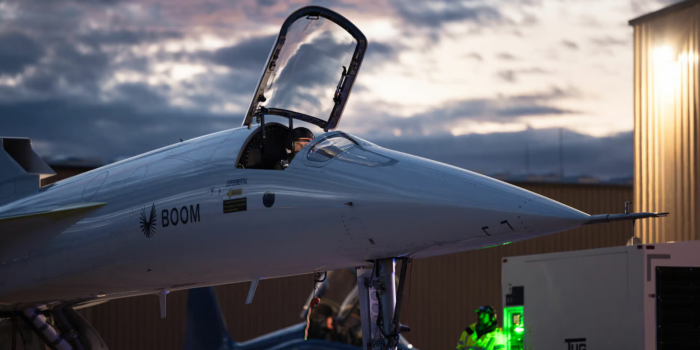Boom Supersonic, a private aerospace startup, completed the first flight of its carbon fiber XB-1 demonstrator aircraft last week by getting it airborne and back down again. Although it hasn’t yet broken the sound barrier, Boom hopes to fly a fuel-efficient supersonic passenger airliner in the future, and this new aircraft is noteworthy for having created the groundwork for it.
The aircraft, launched on Friday from Mojave Air & Space Port in Mojave, California, was made of carbon fiber composites, had a conventional jet engine, and an augmented reality heads-up display for the human pilot. The renowned Bell X-1, which looked like a Jetson and was used by Chuck Yeager to break the sound barrier in 1947, made its maiden supersonic flight not far from Rogers Dry Lake.
The demonstrator, measuring 19 meters in length and 62.6 feet in height, accomplished the test objectives by reaching a height of 2,170 meters and a speed of 273 miles per hour (439 kph). Watch the video below for the Boom XB-1’s inaugural flight; the plane takes off at 1:10 for those who lack patience.

Former British Airways Chief Concorde Pilot Mike Bannister stated in a Boom press release, “I’ve been waiting over 20 years for an environmentally friendly successor to Concorde, and XB-1’s first flight is a major landmark towards my dreams being realized.”
“This day was inevitable, even when I took my last Concorde flight in 2003. An important step toward achieving sustainable supersonic flight is the first flight of the XB-1 supersonic demonstration.”
The problem with the Concorde, a supersonic passenger airliner that could take less than three hours to reach London from New York City, was economic sustainability. According to the Museum of Flight, the cost of supersonic travel was rising even before the catastrophic disaster that killed 113 people in 2000. Aside from that, the aircraft’s loud sonic booms prevented it from traveling faster than supersonic levels over open seas. As a result of city complaints over aircraft noise, all commercial aviation is now subsonic.
Boom intends to build the Overture airliner using sustainable aviation fuels (SAF) made from recycled carbon dioxide, forest scraps, algae, and other elements. Gizmodo pointed out in 2021 that the company does not guarantee that the airplane would run on these fuels; it just assures that it will be “optimized” for them.
Although Overture is still a concept, Boom claims it can transport 64–80 people at Mach 1.7. United Airlines committed to buying 15 supersonic aircraft from Boom in 2021, with the option to buy up to dozens more. According to The Washington Post, Boom plans to introduce the Overture jet around 2029.
In 2024, other supersonic demonstrators will be in the sky than the Boom XB-1. NASA’s X-59, popularly referred to as the Quesst mission, is anticipated to launch later this year. The Quesst mission’s goal, in contrast to the Boom demonstration, is to accomplish sonic boom-less flying, lowering noise pollution to a “sonic thump,” as the agency puts it. The NASA plane has a more unique design than the Boom plane. Its mission is expected to last until 2027.
The Federal Aviation Administration forbids civil aircraft from exceeding Mach 1 when flying over land. Something will have to change if the Boom team wants to achieve considerably shorter cross-country trips and Mach 1.7 with its aircraft.


